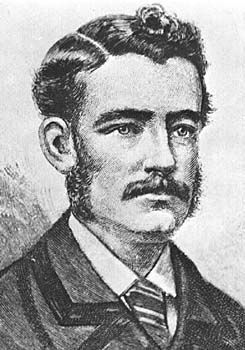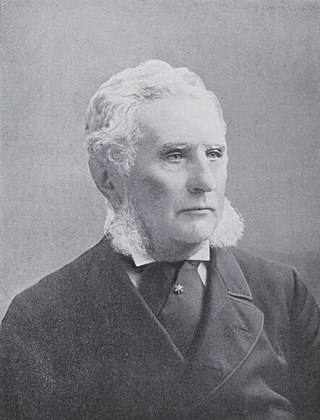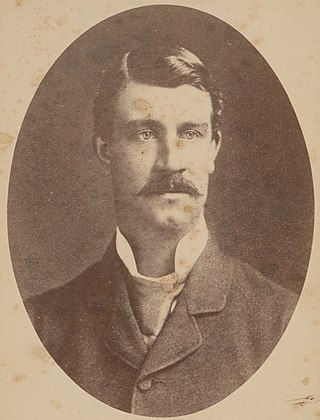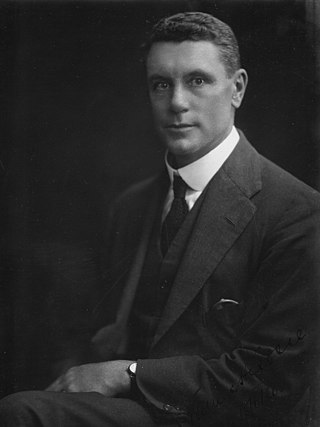Related Research Articles

William Christie Gosse was an Australian explorer, remembered for his 1873 expedition to Central Australia, whose purpose was to explore the area south of Alice Springs and west of the Transcontinental Telegraph Line. He made useful additions to the discoveries of Ernest Giles.

Alexander Hay was a South Australian merchant, pastoralist and politician.
William Gosse Hay was an Australian author and essayist.
Samuel Goode was a mayor of Adelaide, South Australia.
Francis Clark and Son was an engineering business in the early days of South Australia, which later became Francis Clark and Sons.

Townsend Duryea and his brother Sanford Duryea were American-born photographers who provided South Australians with invaluable images of life in the early colony. Their parents were Ann Bennett Duryea (1795–1882), and Hewlett K. Duryea (1794–1887), a land agent, possibly a member of the family well known for starch manufacture in Glen Cove, Long Island, in New York City.
Robert Waters Moore M.R.C.S. born in Cork, Ireland, was a prominent surgeon and medical practitioner in the early days of the colony of South Australia. He succeeded Dr. William Gosse as Colonial Surgeon.

Charles Gosse was a surgeon in the early days of the colony of South Australia.
Crawford and Company was a major grocery store in the early days of Adelaide; for many years the largest family owned concern in the colony.

The Advanced School for Girls was a South Australian State school whose purpose was to prepare girls to qualify for entry to the University of Adelaide. Founded in 1879, the school merged with Adelaide High School in 1907.

Sir James Hay Gosse was an Australian businessman, sportsman, and philanthropist. He was involved with a number of different companies and community organisations in and around Adelaide, South Australia.

Phoebe Chapple was a South Australian medical doctor, decorated for her heroic service in France during World War I.
William Gardner was a surgeon in the British colonies of South Australia and Victoria.
Horatio Thomas Whittell MD., MRCS., generally referred to as H. T. Whittell or H. Thomas Whittell, was a medical doctor in South Australia and Adelaide's City Coroner.
The Office of Colonial Surgeon was, during the days when South Australia was a British colony, a salaried Government position, whose duties and responsibilities were defined by the Parliament of the day. From 1870 it was de facto attached to the post of Surgeon to the Lunatic Asylum / Mental Hospital, with no additional salary. The title persisted for some years after Federation and Statehood and dropped in 1912.
William Anstey Giles, generally known as Anstey Giles, was a surgeon and medical administrator in Adelaide, South Australia.
Julia Warren Farr née Ord was an English-born South Australian philanthropist.
Rupert Walter Hornabrook was a medical doctor, recognised as Australia's first specialist anaesthetist.
Rev. Francis Williams was headmaster of St Peter's College, Adelaide, South Australia.
References
- ↑ Smallwood, Joseph R. et al., eds, Encyclopedia of Newfoundland and Labrador Vol. 2 Newfoundland Book Publishers Ltd. pp.574,576
- 1 2 3 4 "Obituary". South Australian Register . Adelaide: National Library of Australia. 1 August 1883. p. 2 Supplement: Supplement to the South Australian Register. Retrieved 3 April 2012.
- ↑ "Medical Memories". The Register . Adelaide: National Library of Australia. 28 July 1921. p. 2. Retrieved 23 May 2012.
- ↑ "Out Among The People". The Advertiser . Adelaide: National Library of Australia. 31 October 1951. p. 4. Retrieved 25 May 2012.
- ↑ "Notice of Partnership". South Australian Register . Adelaide: National Library of Australia. 8 April 1873. p. 2. Retrieved 23 May 2012.
- ↑ Gosse, Fayette, 'Gosse, William Christie (1842–1881)', Australian Dictionary of Biography, National Centre of Biography, Australian National University, accessed 22 May 2012
- ↑ "Family Notices". South Australian Register . Adelaide: National Library of Australia. 3 July 1885. p. 2. Retrieved 3 April 2012.
- ↑ "Obituary". South Australian Register . Adelaide: National Library of Australia. 5 January 1897. p. 3. Retrieved 24 May 2012.
- ↑ Wilde, William H.; Hooton, Joy; and Andrews, Barry (eds.) The Oxford Companion to Australian Literature 2nd ed. Oxford University Press 1994 ISBN 0 19 553381 X
- ↑ "Family Notices". South Australian Register . Vol. LIII, no. 12, 974. South Australia. 13 June 1888. p. 4. Retrieved 16 March 2024– via National Library of Australia.
- ↑ "Northern Territory Times". Northern Territory Times and Gazette . Darwin, NT: National Library of Australia. 23 June 1888. p. 3. Retrieved 23 May 2012.
- ↑ "Out Among The By vox People". The Advertiser . Adelaide: National Library of Australia. 31 October 1951. p. 4. Retrieved 25 May 2012.
- ↑ "The Home for Incurables". South Australian Register . Adelaide: National Library of Australia. 18 October 1884. p. 1 Supplement: Supplement to the South Australian Register. Retrieved 24 May 2012.
This reference has much detail on the foundation and operation of the centre.